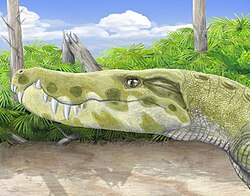Stratiotosuchus
|
Stratiotosuchus Temporal range: Late Cretaceous, Campanian–Maastrichtian |
|
|---|---|
 |
|
| Life restoration of Stratiotosuchus maxhechti | |
| Scientific classification | |
| Kingdom: | Animalia |
| Phylum: | Chordata |
| Class: | Reptilia |
| Branch: | †Sebecosuchia |
| Family: | †Baurusuchidae |
| Subfamily: | †Baurusuchinae |
| Genus: |
†Stratiotosuchus Campos et al., 2001 |
| Type species | |
|
†Stratiotosuchus maxhechti Campos et al., 2001 |
|
Stratiotosuchus (from Greek, (stratiōtēs, "soldier") and (suchos, "crocodile")) is an extinct genus of baurusuchid mesoeucrocodylian from the Adamantina Formation in Brazil. It lived during the Late Cretaceous. The first fossils were found in the 1980s, and the type species Stratiotosuchus maxhechti was named in 2001. A hyperpredator, it and other baurusuchids may have filled niches occupied elsewhere by theropod dinosaurs.
Stratiotosuchus has a deep, laterally compressed skull 470 millimetres (1.54 ft) long. It reached up to 4 metres in length, making it about the same size as Baurusuchus. The teeth are ziphodont, meaning that they are laterally compressed, curved, and serrated. Like other baurusuchids, Stratiotosuchus has a reduced number of teeth: three in its premaxilla and five in its maxilla. When the jaw is closed, the teeth of the upper jaw overlie those of the lower jaw and shear closely together. Stratiotosuchus has one large caniniform tooth in its premaxilla, and several large maxillary teeth behind it. An enlarged fourth dentary tooth in the lower jaw also forms a canine, and is visible when the jaw is closed.
Like all crocodyliforms, Stratiotosuchus was quadrupedal. Unlike the sprawling gait of crocodilians living today, Stratiotosuchus is thought to have been a fully erect quadruped. The transition from a sprawling, low to the ground posture in the ancestors of Stratiotosuchus to an erect, elevated posture involved a significant transformation of the limbs, hips, and shoulders.
...
Wikipedia
